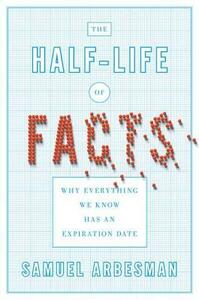Take a photo of a barcode or cover
49 reviews for:
The Half-life of Facts: Why Everything We Know Has an Expiration Date
Samuel Arbesman
49 reviews for:
The Half-life of Facts: Why Everything We Know Has an Expiration Date
Samuel Arbesman
I found this book both fascinating and accessible. Going in, I expected a deep dive into the philosophy of science, with touchstones like Thomas Kuhn front and center. But Kuhn doesn’t make an appearance until the final chapter. Instead, this is a book deeply grounded in the hard sciences, filled with insights from network theory, epidemiology, and information science.
Arbesman’s central claim is that knowledge is constantly evolving—and that this evolution is often predictable. Most "facts" eventually expire, replaced by updated information. In fact, the author suggests that many disciplines operate on an unofficial half-life of about 50 years (though this varies by field).
One of the more compelling ideas is that the spread of knowledge—and misinformation—follows patterns similar to virus transmission. Once incorrect knowledge enters the public consciousness, it’s notoriously hard to root out. Exhibit A: the Brontosaurus.
Arbesman even jokes (perhaps half-seriously) that the best strategy might be to stop trying to memorize anything at all. Instead, use search engines often. The logic? The more frequently you check, the less likely you are to rely on outdated knowledge.
One of my favorite anecdotes involves a satirical academic article, published under the name of Sherlock Holmes' arch-nemesis (on April 1st, no less). Despite all the clues, it was cited in genuine academic publications—and eventually found its way into an encyclopedia. A perfect case study in how even absurdities, if left unchecked, can calcify into "fact."
The book also makes a strong case for interdisciplinary collaboration. Problems deemed unsolvable in one field may be easily resolved by someone in another. Arbesman gives the example of his father, a dermatologist, who came across an open neurology problem: measuring ALS progression. He proposed a novel approach—tracking changes in skin resistance—a method neurologists hadn’t considered. This cross-disciplinary solution highlights the power of looking beyond disciplinary silos.
Highly recommended!



